Big Adventures and Wild Adventures on The Great White Continent
Maybe it’s the thrill that comes from being in this place where so relatively few have travelled before you. Or the sheer grandeur of massive icebergs that gurgle and tremor as you pass. Whatever the case, your heart skips a beat the moment you set foot on the Great White Continent. It’s a sublime, iconic and humbling place all at once.
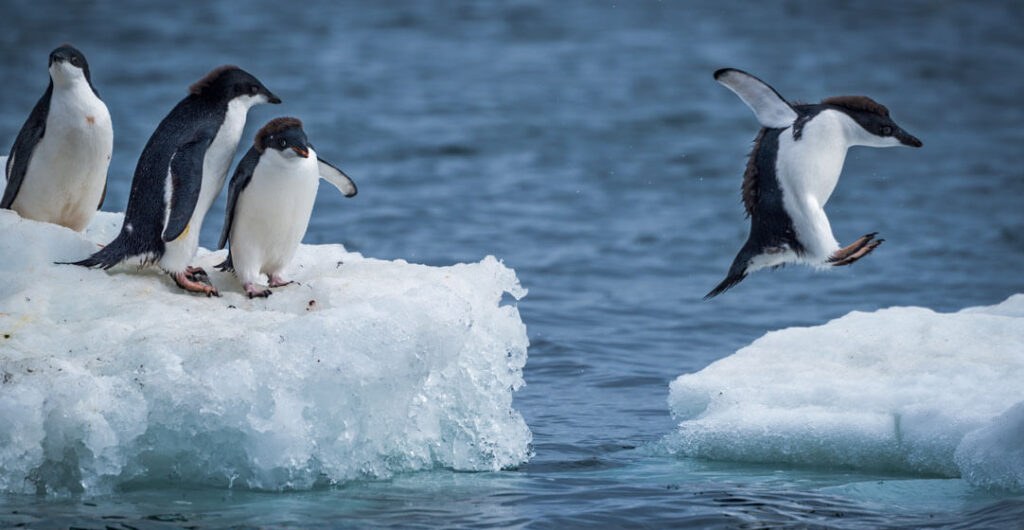
Antarctica is earth’s last great wilderness, a 5.5-million-square-mile expanse that’s covered mostly in ice and has welcomed some of the world’s most legendary explorers: names like Ernest Shackleton, Norwegian Roald Amundsen — who lead the first-ever expedition to reach the South Pole — and Ann Bancroft, who later crossed the Pole on skis. It’s also the world’s coldest, driest and windiest continent — a land that’s inhospitable to humans, but where wildlife such as penguins, whales and seals thrive.
The travel season to Antarctica is short — typically beginning in late October and running through mid-March, though it’s entirely dependent on the weather. This also goes for the trips themselves. Despite the best-laid plans, dire sleet and winds might cancel expeditions one day, or your ship could find itself in a sea of ice so thick the only way onto land is to walk. If you’re truly lucky, you’ll experience one of those rare “bluebird days,” when the skies are clear, the air still and the opportunities for kayaking, paddleboarding and in some cases, helicopter touring, are seemingly endless.

Know Before You Go
There are a couple of reasons why Antarctica remains the planet’s last great frontier.
Back in 1959, 12 countries that were active in Antarctic scientific research signed The Antarctic Treaty, an unprecedented agreement designating the entire Antarctic continent as a “natural reserve, devoted to peace and science.” Forty-three more parties such as Brazil, China and Spain have since signed on to this pact, which now includes additional protocol covering environmental protection. Some of its key elements are banning the introduction of non-native species, establishing rules for waste disposal and prohibiting the discharge of oil and noxious liquid substances in Antarctic waters.
Like the bulk of ships heading to Antarctica, the 200-passenger luxury expedition yacht that I traveled on was a member of The International Association of Antarctica Tour Operators (IAATO), an organization founded in 1991 to advocate and promote the practice of safe and environmentally responsible private-sector travel to the Antarctic.
According to IAATO protocol, only a restricted number from a single vessel are allowed onto land at one time and only for two hours at a time. Tour operators also choose their landing locations well-prior to an expedition, assuring that when you’re out there it’s just you, your shipmates, and the stark, white world.
Getting There
While reaching Antarctica is becoming increasingly easier, with several cruise lines offering chartered flights directly to the continent, the standard (and let’s face it, the one that will earn you the most street-cred) way of traveling there is via ship across the Drake Passage, a notoriously stomach-churning body of water that’s legendary in its own right.
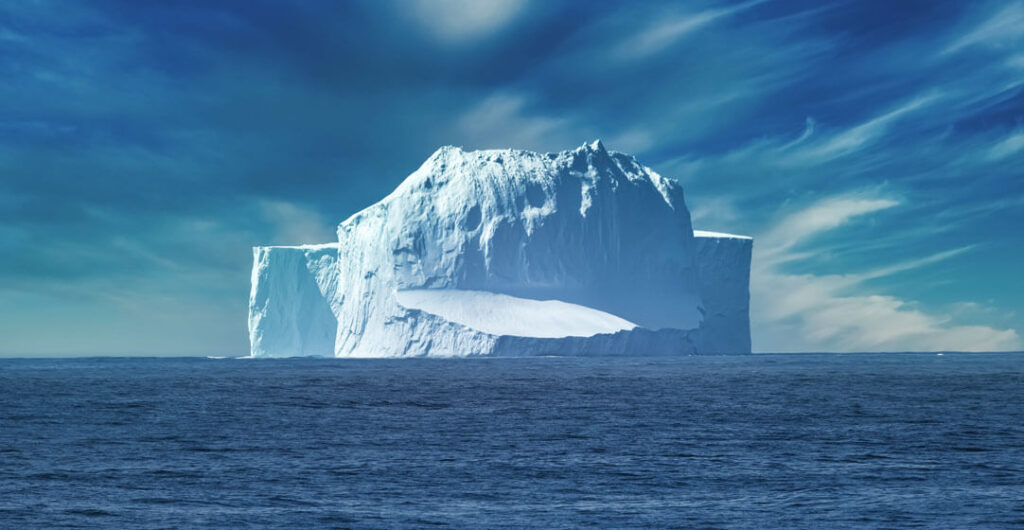
The passage is where the Atlantic and Pacific oceans meet and extend south into the Southern Ocean. It’s a formidable stretch of high winds, tremendous currents and massive swells that can tower up to 40-feet-tall. The “Drake Lake” is the sea’s nickname on calm days, though enduring the much rougher “Drake Shake,” the passage’s moniker during rougher waters, is a journey that’s extremely well earned.
My ship, Scenic Eclipse, was a Polar Class 6, the highest ice-class rating (just one class below an ice-breaker) of any passenger ship and one fitted with custom-built stabilizers, which made a huge difference in smoothing out any rocking from the rough seas.
Holding its own in 13-to-20-foot tall swells after departing from the Argentinian port city of Ushuaia, the ship progressed at an average speed of 16 knots over two full days. Occasionally, a wandering albatross would soar through the air beside us, while fluttering petrels often followed in our wake. After crossing the Antarctic Circle at 66 degrees south of the equator (a perk that not every traveler to Antarctica gets to claim), we continued to our first stop — Marguerite Bay, on the west side of the Antarctic Peninsula — and the beginning of a truly unforgettable eight-day expedition.
The Experience
Every day on “The Ice” brought a new adventure, from perusing the seas in a series of sturdy, inflatable Zodiac boats to seek out orca whales and serpent-like leopard seals, to going onshore to see plump Adélie penguins — recognizable by the distinct white rings around their eyes — waddling across rocky terrain.
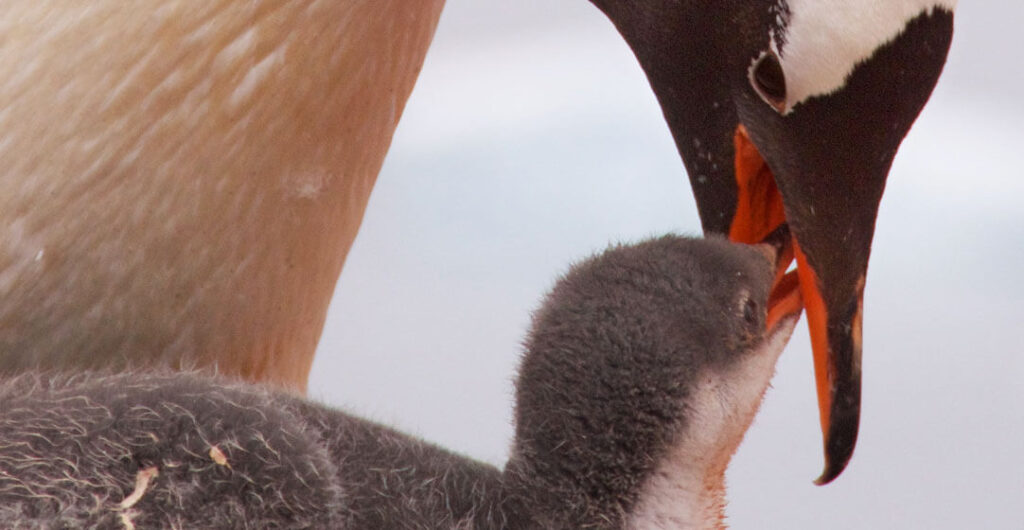
On Horseshoe Island, we entered the remains of a British scientific research station from the 1950s (now a historic site and monument), still stocked with its original kitchen utensils, magazine stacks and radio equipment. In fact, the continent’s coastline and offshore islands are dotted with research stations occupied by scientists from countries like Argentina, the United Kingdom and the United States. Many of them welcome visitors with prior arrangements.
In calmer waters, such as those in the peninsula’s Neko and Orne harbors, the ship brought out its stand-up paddleboards and tandem kayaks and we took to the sea in full-body dry suits, navigating among floating patches of ice and chinstrap penguins. Aptly named for the thin black band below their head, they use their wings like flippers to propel themselves out of the water in one svelte line.
On land, our ship’s Discovery Team marked out safe routes for traversing, avoiding breeding penguin colonies and the deep crevasses that lay hidden along Antarctica’s hilly and glaciated terrain. Throughout the expedition, they taught us how to differentiate between the continent’s vast ice masses, from its popping and hissing glaciers — composed of centuries of compressed snow and pressurized ancient air bubbles that escape with the ice’s melting — to free-floating icebergs that roll and calve. The denser an iceberg, the bluer and many (like those in spectacular Cierva Cove) stand like artisan sculptures in abstract shapes and mouth-gaping hues.
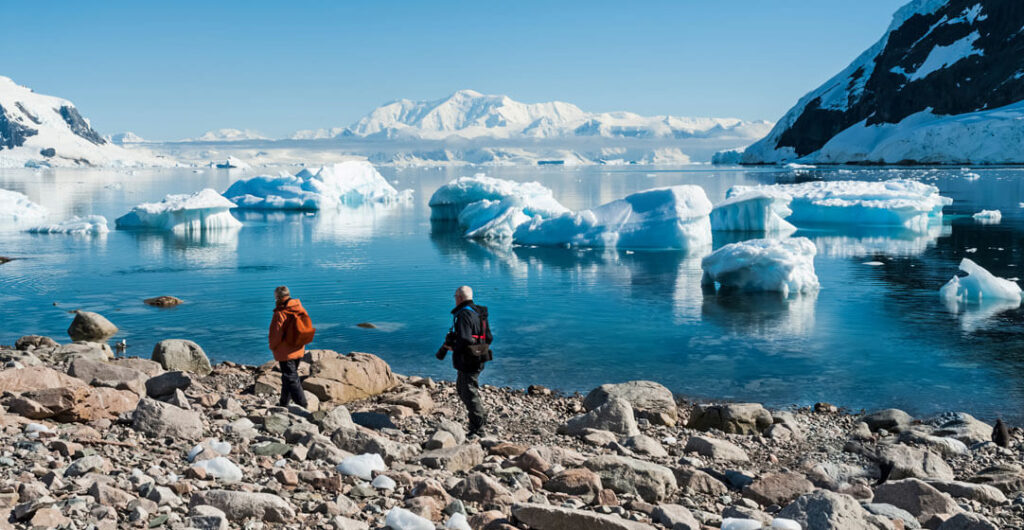
Land of Penguins
From the krill-feeding humpback whales of Fournier Bay, who playfully slapped their tail flukes and spouted plumes of water into the air as we watched from our Zodiacs, to the hundreds of gentoo penguins (identifiable by their red-orange beaks, orange feet and a white stripe over their eyes) meandering and molting along Cuverville Island’s rocky terrain, each day was a surprise.
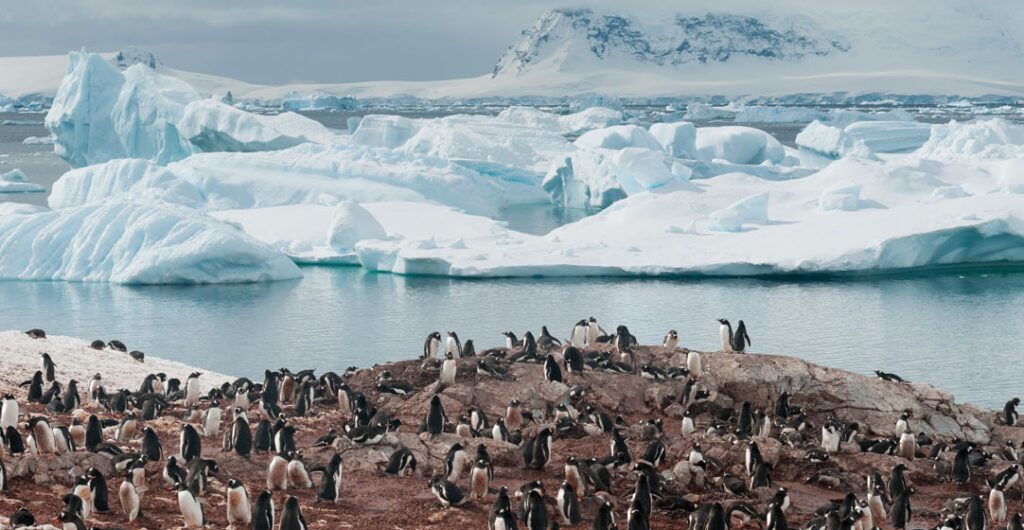
One morning a penguin might toddle right up to you, while others were busy building nests with whatever pebbles, feathers and bones they could find. We’d often spot one stealing from another, scooping into its beak the pebbles of a neighbor and reclaiming them as its own.
Despite their patchwork plumes, pungent smell and noisy screeches, Antarctica’s penguins still managed to ooze charisma, but they’re not the only wildlife that excites at earth’s end. We jumped at the chance to see a leopard seal lounging on pack-ice, its Joker-like grin hiding incredibly powerful, inch-long canine teeth, and marveled at the many crabeater and Weddell seals barking, lazing and swimming aside our boats.
Still, that places like this still exist is the real grandeur of Antarctica — a raw and unspoiled land that’s worth every Drake Shake swell.
—Written by Laura Kiniry
Travel Planning Tips
Get expert advice: Your perfect getaway awaits. No matter what destination you choose, or how you wish to travel, AAA Travel experts can help you plan a perfect experience that you will remember for years to come.
Consider Concierge: AAA’s Concierge Vacations feature done-for-you details and special amenities for travel to world-wide destinations. AAA Travel Agents will make your planning a breeze and your vacation unforgettable.
On the road: Get ready for every trip with a AAA Membership. Get peace-of-mind on the road and travel insurance.
Save with discounts: AAA membership gives you access to exclusive discounts nationwide.









